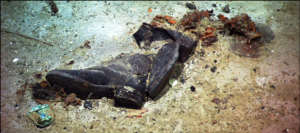The sinking of the Titanic on April 15, 1912 killed over 1,500 people and pulled the ship and everything inside of it to the bottom of the Atlantic Ocean. The remains of the ship and its passengers sit 2.5 miles underneath the surface, and studying the artifacts left behind could lead to understanding what life was like for those on board and answer questions surrounding how the wreck occurred. Underwater preservation and surveying techniques have allowed archaeologists to go down and investigate the site; that is, as long as they make it to the Titanic before it completely deteriorates.
When the remains of the Titanic were discovered in 1985, ocean archaeology technology was relatively primitive. Sonar was developed so that deep-sea endeavors would be safer and as technology has improved, underwater archaeology has grown. In 1985, Woods Hole Oceanographic Institution (WHOI) sent an unmanned ship with cameras and a sonar system down to take photographs and videos of the wreck and successfully brought the images back so that the public could see what had happened.
The ocean is rough terrain preserve artifacts in. In the 34 years since it was found, rust, salts, microbes, and deep-sea creatures have been slowly destroying the once magnificent ship and have completely consumed any human remains there. Scientists and archaeologists are afraid that the site of the Titanic will completely vanish within the next few years. An expedition went to the Titanic in August of this year, and the ship is completely broken in half, consumed by ocean life. The decay was expected and the site was made a priority. In 2010, ships were sent down to make a complete replica of the site using videos, 3-D imaging, and sonar technology so that there would be a record of the ship before it completely deteriorates.
While having a map of the site is great so that there is some kind of record of what happened, it may not be an accurate representation of what the ship was like when it sank. Because the Titanic sank in international waters, the wreck was under no national jurisdiction until 2012. The company that owned the ship went out of business, so that meant that until the ship became a UNESCO world heritage site, anyone could visit the site and bring back artifacts. For a shipwreck to be protected under UNESCO, it has to be underwater for 100 years. This meant that between 1985 and 2012, anyone could go down to the Titanic and potentially damage the ship and take its artifacts. Unwanted visitors have gone down to the ship and left modern trash that has damaged the rapidly deteriorating ship. We may not know exactly what happened due to looters and vandals, but at least there is a record of what it might have been like before the Titanic returns to its elemental form and vanishes forever.
References:
https://www.nytimes.com/2019/08/21/science/titanic-shipwreck-archaeology.html
Figures from:
https://www.archaeology.org/exclusives/articles/651-titanic-jean-louis-michel-robert-d-ballard
https://sanctuaries.noaa.gov/maritime/titanic/expedition_results.html
Additional Reading:
https://sanctuaries.noaa.gov/maritime/titanic/welcome.html
https://www.archaeology.org/exclusives/articles/651-titanic-jean-louis-michel-robert-d-ballard











